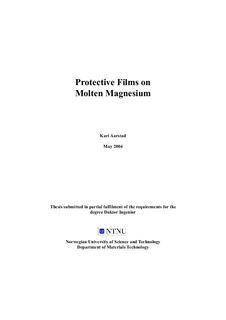| dc.description.abstract | Molten magnesium will oxidize uncontrollably in an atmosphere of air. To inhibit this, a protective gas is used to cover the melt. The gas most commonly used today is SF6. Fluorine is known to be the active component of the gas. There is a major problem with SF6, and that is that it has a strong Global Warming Potential (GWP). The GWP of SF6 is 23 900 times that of CO2.
The aim of the present work is to understand the mechanism of the protection of molten magnesium. Hopefully, this allows us to find less problematic alternatives to the use of SF6 gas.
The present work was performed with three different experimental units:
- A furnace was especially built to expose molten magnesium to various atmospheres.
- A hot stage made it possible to study the surface of the molten or solid sample under the microscope at high temperature with SF6 or with other gases in the atmosphere.
- Finally, the solubility of fluorine in magnesium was measured at temperatures from 700°C to 950°C.
To obtain a basic knowledge of magnesium melt protection, molten magnesium was exposed to various combinations of gases. Both SF6 and SO2 in air protects molten magnesium well from oxidation. It is also known that pure CO2 has a protective effect. In these experiments, it was tested whether SF6 and SO2 in other carrier gases than air will be protective. Nitrogen, argon and CO2 were used as carrier gases. Also, air was added to CO2 to see how much air the CO2 can contain and still be protective. An important conclusion for SF6 and SO2 is that air is necessary to build a protective film on the melt surface. Inert gases like nitrogen and argon will obviously not oxidize the metal, but since no film forms on the melt, the metal will keep on evaporating. A CO2 atmosphere can contain at least 20% air, and still be protective. Problems employing CO2, are that the metal surface gets discolored, which is at least a cosmetic problem, and that C may be introduced into the metal, which may give corrosion problems.
The hot stage placed under an optical microscope made it possible to observe the magnesium sample as it was heated under an atmosphere of SF6 in air, pure CO2 and 1% SO2 in air. The samples were held at temperatures from 635°C to 705°C for varying holding times. The partial pressure of SF6 was varied between 0.5 and 5%. The samples produced were excellent for further studies with Transmission
Electron Microscope (TEM), Field Emission Scanning Electron Microscope (FESEM), microprobe and Focused Ion Beam Milling (FIB). The examinations showed that a thin, dense film was formed. Magnesium fluoride particles formed on the interface between the metal and the oxide film in some cases. It is suggested that then the magnesium oxide is saturated with fluorine. The fluorine diffuses through the oxide layer and forms magnesium fluoride at the interface between MgO and Mg. In other cases, it is seen that a matrix rich in fluorine forms in between larger oxide grains. Combinations of these two situations are also seen.
Proposed explanations for the protective behavior of SF6 are:
-the formation of a second phase, that is magnesium fluoride, which helps to give a Pilling-Bedworth ratio close to one.
-the formation of a MgO matrix containing F.
The thickness of the films formed with SF6 is found to be proportional to the square root of time. The proportionality constant depends on temperature and the partial pressure of SF6 in the gas.
Samples in CO2 heated above the melting point did not keep their initial shape. The films formed with CO2 are probably therefore not as strong as the films formed in SF6 since these samples managed to keep their initial shape even after they had melted. The surfaces after exposure to CO2 were black and uneven. Formation of MgCO3 has not been confirmed in this work. Also thermodynamic calculations indicated that MgCO3 does not form.
It was not possible to tell experimentally whether the sulphur found in the samples exposed to SO2 is bound as magnesium sulphide or magnesium sulphate or even dissolved in MgO, although it may look like two different phases are present with a slightly different sulphur content. Thermodynamic calculations do not indicate that MgSO4 should form.
It was considered to introduce fluorine directly into the melt as an alternative to the use of SF6. In this case formation of MgF2 would limit the content of fluorine in the molten magnesium. Therefore, the solubility of fluorine in molten magnesium has been studied by melting magnesium in a magnesium fluoride crucible. Samples were taken at various temperatures from 700°C up to 950°C. Three different analytical methods were employed to measure the fluorine content: The Sintalyzer method, Glow Discharge Mass Spectrometry (GD-MS) and Secondary Ion Mass Spectrometry (SIMS). The various analytical methods did not all give the same results. However, it is suggested that the SIMS results are the most reliable. The value for the dissolution of fluorine, 1/2 F2 (g) =F (in mass%) is then:
ΔG°3/2 = (- 329 000 + 65 000) - (83+64)T
ΔGo for the equilibrium between magnesium and magnesium fluoride,
MgF2 = Mg (l) + 2F is found to be:
ΔGo = (471 000 ± 131 000) - (350±130) T
Iron is found to have no effect on the solubility of fluorine in molten magnesium.
The solubility of fluorine does not seem to be sufficiently high for direct dissolution of fluorine into the melt to be an alternative to SF6.
Iron is found to have no effect on the solubility of fluorine in molten magnesium.
The solubility of fluorine does not seem to be sufficiently high for direct dissolution of fluorine into the melt to be an alternative to SF6. | nb_NO |
